

Electric Vehicle Ownership Costs: Today’s Electric Vehicles Offer Big Savings for Consumers
2
Table of Contents
Executive Summary 3
Key Terms 4
Chapter 1—Resale Value 5
Chapter 2—Maintenance 9
Chapter 3—Fuel Costs 12
Chapter 4—Current EV Ownership Costs 18
Chapter 5—Used EVs 26
Appendix A—Fuel-Cost Sensitivities 29
Appendix B—Fuel Costs by State 30
Appendix C—Vehicle Characteristics 33
Appendix D—Depreciation Curve 35
Appendix E—Detailed Results of New-Car Ownership Cost Analysis 36
Appendix F—Sensitivity Cases for New-Car Ownership Cost Analysis 38
Appendix G—Detailed Results of Used-Car Ownership Cost Analysis 43

Electric Vehicle Ownership Costs: Today’s Electric Vehicles Offer Big Savings for Consumers
3
Executive Summary
Up-front purchase price is only part of the cost consumers pay to own their vehicle. Over the
lifetime of a conventional gas-powered vehicle, fuel and maintenance costs can add up to even
more than the original purchase price. While electric vehicles (EVs) typically have higher up-
front purchase prices, they can save consumers a lot on operating expenses. This study relies
on new data on electric vehicle depreciation rates and maintenance and repair costs, along with
real world average vehicle prices, to estimate how much today’s most popular EVs can save
consumers when compared with similar ICE vehicles.
New data obtained by CR from ALG, a data and analytics subsidiary of automotive pricing and
information website TrueCar, shows that when adjusted for federal purchase incentives, both
battery electric vehicles (BEVs) and plug-in hybrid electric vehicles (PHEVs) are expected to
depreciate at the same rate as ICE vehicles in the same class over the first five years of
ownership. In addition, new data extracted from recent Consumer Reports reliability surveys
shows that both BEV and PHEV drivers are saving 50 percent on their repair and maintenance
costs, when averaged over a typical vehicle lifetime.
Based on average driving habits, fuel costs for BEVs were estimated assuming mostly home
charging and an estimated six fast-charging sessions required per year for BEVs with a range of
250 miles. Overall, BEVs were estimated to save consumers about 60 percent on fuel costs
compared with the average vehicle in their class. Fuel costs were also analyzed by state, with
the majority of states falling within 10 percent of the national average.
The nine most popular EVs on the market under $50,000 were compared to (1) the best-selling,
(2) the top-rated, and (3) the most efficient vehicles in their class. For six of the nine EVs
analyzed, the first-owner ownership costs are estimated to be lower than those of all three
comparable ICE vehicles in their class. For all nine EVs analyzed, the first-owner ownership
costs are estimated to be lower for at least one of the three comparable ICE vehicles. In many
cases, the EVs matched or exceeded the performance of some of the top-performing ICE
vehicles in their class. For all EVs analyzed, the lifetime ownership costs were many thousands
of dollars lower than all comparable ICE vehicles’ costs, with most EVs offering savings of
between $6,000 and $10,000. While new EVs were found to offer significant cost savings over
comparable ICE vehicles, the cost savings of 5- to 7-year-old used EVs was found to be two or
three times larger on a percentage savings basis.
Overall, these results show that the latest generation of mainstream EVs typically cost less to
own than similar gas-powered vehicles, a new development in the automotive marketplace with
serious potential consumer benefits.

Electric Vehicle Ownership Costs: Today’s Electric Vehicles Offer Big Savings for Consumers
4
Key Terms
Battery electric vehicle (BEV): A vehicle that operates only on electric power.
Depreciation: The portion of the initial value of an asset (such as a vehicle) that has been lost
after a given amount of time. Depreciation is the inverse of the residual value.
Discount rate: An interest rate used for discounting future income and expenditures relative to
the present value.
Electric vehicle (EV): A vehicle capable of operating on electricity only for an extended period
of time. Includes battery electric vehicles, plug-in hybrid electric vehicles and fuel cell electric
vehicles
1
.
Internal combustion engine vehicle (ICE): A conventional vehicle fueled only by gasoline.
Plug-in hybrid electric vehicle (PHEV): A vehicle that can operate on either electricity or
gasoline.
Present value (PV): A sum of future income and expenditures discounted to current year using
a discount rate to take into account the fact that costs and expenditures further into the future
have a lower value in the present.
Residual value: The portion of the original purchase price of a vehicle remaining after a certain
number of years. Residual value is the inverse of depreciation.
1
There are currently no high-volume mainstream fuel cell electric vehicles.

Electric Vehicle Ownership Costs: Today’s Electric Vehicles Offer Big Savings for Consumers
5
Chapter 1—Resale Value: Long-Range Electric Vehicles Expected to Hold Value As Well
As Internal Combustion Engine Vehicles
Introduction
The electric vehicle market is rapidly changing, largely because the cost of batteries has
decreased dramatically over the past decade.
2
One of the most significant changes is extended
driving range. The 2011 Nissan Leaf, for example, had a single-charge range of only 73 miles,
whereas the 2019 version had three times that range, at 226 miles. As of model year 2020, at
least 11 electric vehicles on the market have a range of 200 miles or more. This sharp
improvement in range delivers far more utility for many consumers.
This increased utility is likely to be reflected in higher resale values for the current model year of
the Leaf and other higher-range EV models. The purposes of this chapter are to test this
hypothesis and estimate how the values of these electric vehicles will hold up over time. The
analysis relies on data from proprietary algorithms developed by ALG based on real-world
vehicle transaction prices adjusted by CR to account for government purchase incentives.
Key Findings
● Current longer-range battery electric vehicles (BEVs) are expected to maintain their
value about as well as comparable internal combustion engine (ICE) vehicles, on
average, over the next five years.
● Plug-in hybrid electric vehicles (PHEVs) are expected to hold their value about as well
as conventional hybrids of the same vehicle class, on average, over the same period.
Approach
ALG, a data and analytics subsidiary of automotive pricing and information website TrueCar
provided CR with projected residual values of all model year 2019 vehicles after five years of
ownership as a percentage of the average original price for each model. These projections were
made using proprietary algorithms and data from millions of real-world new and used vehicle
transactions.
These residual value estimates were then adjusted to take into account the effect of purchase
incentives available at the state and federal level on the original price of battery electric and
plug-in electric vehicles. This was necessary because the net price after incentives represents
2
https://www.bloomberg.com/news/articles/2020-03-17/an-economic-crash-will-slow-down-the-electric-
vehicle-revolution-but-not-for-long

Electric Vehicle Ownership Costs: Today’s Electric Vehicles Offer Big Savings for Consumers
6
the true price paid by consumers for these vehicles, and it is expected that both the new- and
used-car markets will reflect the availability of these incentives.
ALG provided estimates of residual values based on the month of purchase, and the data were
updated every two months throughout the year, resulting in six data points per year. Because
incentives were phased out for some automakers—General Motors and Tesla, for example—at
different points throughout the year, the incentives were applied only for the months in which
they were offered, and the resulting residual values were averaged across the six data points for
each vehicle for the year.
The value of the federal tax credit for each vehicle model was taken from fueleconomy.gov.
3
For
state incentives, a weighted average incentive for all BEVs was derived by multiplying the
percentage of EV sales in 2019 in a given state
4
by the value of the state purchase incentive for
BEVs.
5
Ten states provided purchase incentives for BEVs in 2019, and those states accounted
for 65 percent of national EV sales. From this, it was calculated that, on average, BEV vehicles
sold in 2019 each received $1,400 in state purchase incentives. Because vehicles are often sold
across state lines, we used this weighted average to approximate the effect of state incentives
on the overall market. State tax credits were not calculated for PHEVs because of the
complexity of how different state incentives apply to different specific PHEV models based on
battery size.
Detailed Results
Electric vehicles were grouped into different segments, based on range and price, for analysis.
Vehicles were segmented by whether they were classified as luxury or mainstream by TrueCar,
and the mainstream EVs were divided by range: greater than 200 miles, between 100 and 200
miles, and under 100 miles. All luxury BEVs had a range of over 200 miles.
Table 1.1 shows a summary of the predicted five-year residual values for each category, with
different levels of adjustment (adjusted for federal tax credit, and adjusted for both federal and
state tax credits). These values are then compared with the predicted average residual values
for comparable conventional internal combustion engine (ICE) vehicle segments. The residual
values in the table represent the portion of the effective initial purchase price that is retained
after five years of ownership, which is the inverse of depreciation. For example, a residual value
of 0.45 indicates that the vehicle has depreciated by 55 percent.
3
https://www.fueleconomy.gov/feg/taxevb.shtml.
4
https://www.atlasevhub.com/materials/state-ev-sales-and-model-availability.
5
https://afdc.energy.gov/laws/state.

Electric Vehicle Ownership Costs: Today’s Electric Vehicles Offer Big Savings for Consumers
7
The data show that with the exception of mainstream BEVs with less than 100 miles of range,
all EV categories are expected to hold their value approximately as well as comparable internal
combustion engine vehicles.
It should be noted that every vehicle in the under-100-mile category is a low-volume car with
sales of less than 1,000 units in 2019
6
and available only in states with zero-emissions vehicle
mandates. This indicates that these vehicles were likely sold largely for compliance reasons, not
as mass-market vehicles that were compelling to a broad cross-section of consumers.
Table 1.1. Average Predicted 5-Year Residual Values for EVs Compared with ICE Vehicles
EV/PHEV
Category
Adjusted for
Federal Tax
Credit
Adjusted for
Federal and
State Tax
Credits
Comparable
ICE
ICE Segment
Comparison
Luxury EV
(n=6)
0.47
0.48
0.46
Luxury car, luxury
SUV, luxury
performance
Mainstream
200-plus-mile
range
(n=4)
0.44
0.46
0.45
Compact car
Mainstream
100- to 200-mile
range (n=4)
0.43
0.45
0.45
Compact car
Mainstream
<100-mile range
(n=3)
0.28
0.29
0.36
Subcompact car
PHEV
(n=12)
0.47
0.48
Hybrid
Luxury PHEV
(n=10)
0.43
0.45
Luxury hybrid
6
https://insideevs.com/news/343998/monthly-plug-in-ev-sales-scorecard.
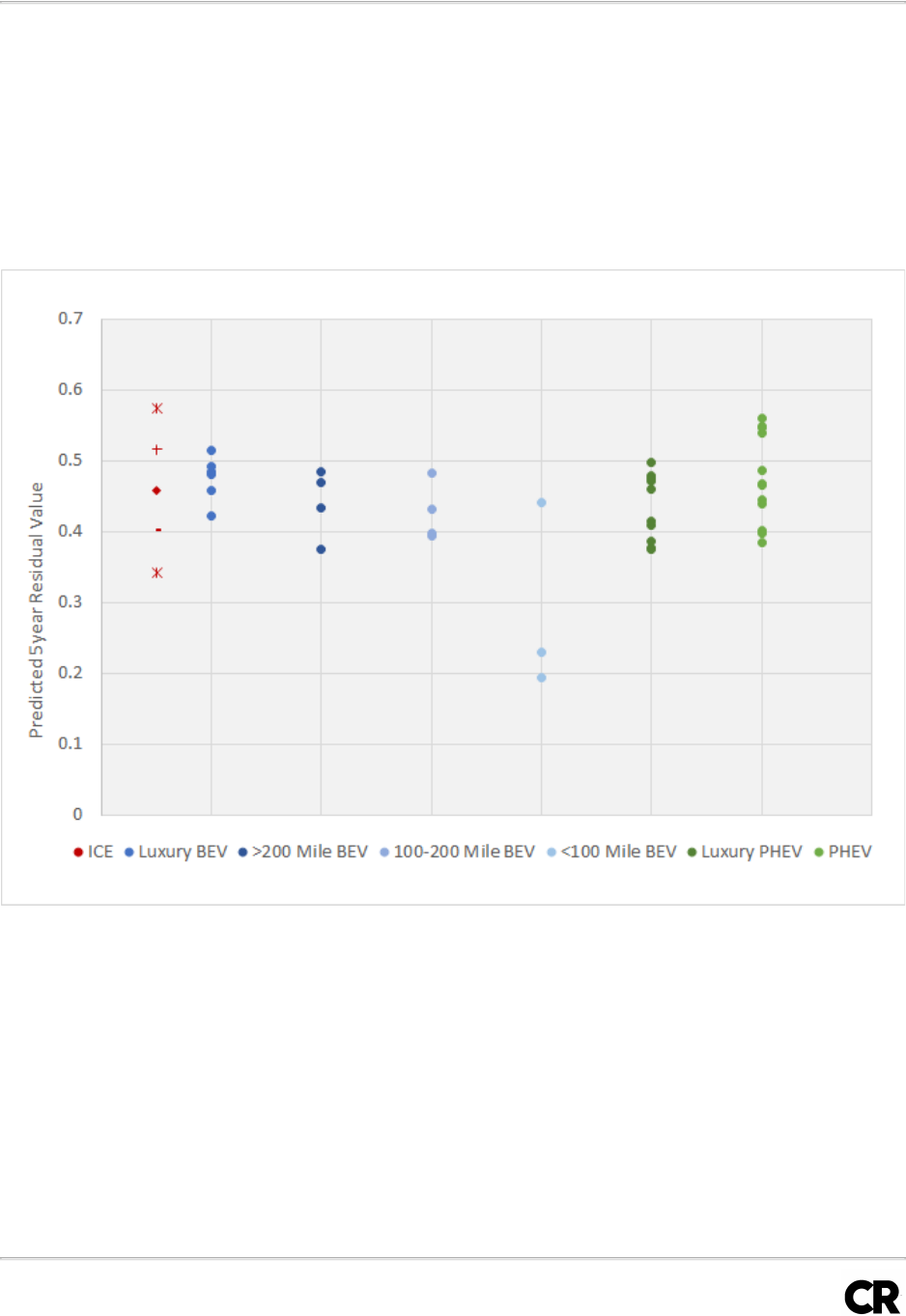
Electric Vehicle Ownership Costs: Today’s Electric Vehicles Offer Big Savings for Consumers
8
The predicted residual data adjusted for federal tax credits are also shown as a scatter plot of all
vehicles in each category in Figure 1.1. ICE values are shown for comparison as the average
(represented by ◆), +/- one standard deviation (+ and - symbols), and +/- two standard
deviations (*) by combining the compact car, midsized car, and compact-utility categories. This
illustrates that, like ICE vehicles, not all EVs are expected to hold their value the same, and that
other vehicle- and manufacturer-specific factors, such as style, features, reliability, and
manufacturer reputation, still affect the relative depreciation of different vehicles.
Figure 1.1. Scatter Plot of Predicted 5-Year Residual Values for EVs by Type and Range
Adjusted for Federal Tax Credit

Electric Vehicle Ownership Costs: Today’s Electric Vehicles Offer Big Savings for Consumers
9
Chapter 2—Maintenance: EVs Cost Half as Much to Maintain
Introduction
Electric vehicles (EVs) are generally expected to cost less to maintain because their electric
motors and other drivetrain components have fewer moving parts than internal combustion
engines, and they don’t require fluid changes.
7
However, because EVs are relatively new, little
hard data are available to put numbers to these claims, and most estimates in the literature are
based on predicted repair and maintenance costs.
8
However, each year CR surveys hundreds
of thousands of our members about the reliability and maintenance costs of their vehicles. In
recent years this survey sample has included more and more electric vehicles, including
thousands of both battery electric vehicles (BEVs) and plug-in hybrid electric vehicles (PHEVs).
This data was analyzed to estimate average real-world repair and maintenance costs for BEVs,
PHEVs, and internal combustion engine (ICE) vehicles.
Key Findings
● Analysis of real-world maintenance and repair cost data from thousands of CR members
shows that BEV and PHEV owners are paying half as much as ICE owners are paying to
repair and maintain their vehicles.
Approach
Data for this analysis came from Consumer Reports’ 2019 and 2020 spring reliability surveys.
9
This comprehensive survey is sent to hundreds of thousands of CR members and is used as
the basis for CR’s reliability ratings. Among many other questions, individual drivers are asked
to estimate how much they spent on repairing and maintaining their vehicle over the past 12
months, as well as how many miles they drove in the past 12 months, and how many total miles
their vehicle has on it.
The data were filtered to remove:
● Incomplete responses.
● Vehicles that reported traveling less than 2,000 miles in the past 12 months.
● Vehicles that reported traveling more than 60,000 miles in the past 12 months.
● Vehicles that reported maintenance costs of over $20,000 over the past 12 months.
● Vehicles with more than 200,000 total miles.
7
https://www.consumerreports.org/hybrids-evs/your-ev-questions-answered-electric-vehicle-faq/#reliable
8
https://theicct.org/sites/default/files/publications/EV_cost_2020_2030_20190401.pdf
9
https://www.consumerreports.org/car-reliability-owner-satisfaction/consumer-reports-car-reliability-faq/

Electric Vehicle Ownership Costs: Today’s Electric Vehicles Offer Big Savings for Consumers
10
These filters on the data were used to eliminate outliers and keep the sample within the range of
reasonably likely consumer experience while retaining as much of the original data set as
possible. While 60,000 miles is a lot of driving for one year, it’s within the range of possibilities
for, for example, a salesman with a large territory, or someone who drives full-time for a ride-
hailing company, such as Uber or Lyft. Similarly $20,000 is a lot to spend on vehicle repairs but
may represent the cost of major repairs on a luxury vehicle.
The final data set was then sorted by total vehicle mileage. Average maintenance costs were
estimated in three mileage bins: 0 to 50,000 miles, 50,000 to 100,000 miles, and 100,000 to
200,000 miles. For each bin, a vehicle-miles-traveled (VMT) weighted average repair and
maintenance cost per mile was calculated. To account for any bias in the data based on the
brands of vehicles purchased by CR members, for ICE vehicles the estimates were reweighted
based on calculated average maintenance costs for each automaker and the average market
share over the past five years for each brand, using data from auto industry analyst Wards
Intelligence.
10
The sample size for PHEVs and BEVs was not large enough to do a similar
automaker weighted average calculation, but for ICE vehicles the difference between the
automaker weighting and the total average sample for each mileage bin was negligible.
Detailed Findings
The results of the analysis are shown in Table 2.1, binned by mileage range and averaged over
a 200,000-mile vehicle lifetime. Notable results are that estimated lifetime average repair and
maintenance costs for BEVs and PHEVs are approximately half the cost for ICE vehicles. This
is generally consistent with other sources that have estimated the relative repair and
maintenance costs of EVs at 40 percent
11
and 47 percent.
12
The data show that repair and maintenance costs are slightly higher for PHEVs than for BEVs
until the 100,000-mile mark, and slightly lower beyond 100,000 miles. It should be noted,
however, that there is a higher degree of uncertainty in these numbers because of a lower
sample size: A little over 200 PHEV vehicles with more than 100,000 miles, and only 55 BEVs.
Furthermore, the 55 BEVs with more than 100,000 miles were predominantly early versions of
the Nissan Leaf and Tesla Model S, suggesting that our projections may overestimate the long-
term maintenance costs expected from current-generation BEVs as automakers learn from their
early models. These estimates will continue to be refined over the next few years as more data
10
Wards Intelligence, U.S. Vehicle Sales by Company, 2015-2019 data series.
https://wardsintelligence.informa.com/WI060875/US-Vehicle-Sales-by-Company-20152019.
11
https://neo.ubs.com/shared/d1ZTxnvF2k.
12
https://www.2degreesinstitute.org/reports/comparing_fuel_and_maintenance_costs_of_electric_and_gas_
powered_vehicles_in_canada.pdf.

Electric Vehicle Ownership Costs: Today’s Electric Vehicles Offer Big Savings for Consumers
11
on more electric vehicles at higher mileages become available in Consumer Reports’ survey
sample.
Table 2.1. Estimated Per-Mile Repair and Maintenance Costs by Powertrain
Powertrain Type
0-50K Miles
50K-100K Miles
100K-200K Miles
Lifetime Average
BEV
$0.012
$0.028
$0.043
13
$0.031
PHEV
$0.021
$0.031
$0.033
5
$0.030
ICE
$0.028
$0.060
$0.079
$0.061
The results are put into the context of consumer budgets in Table 2.2, which shows the lifetime
repair and maintenance costs for vehicles of the different powertrain types. They show that
BEVs and PHEVs will both cost consumers about $4,600 less to repair and maintain over their
lifetimes, compared with ICE models when discounted to the present value.
Table 2.2. Lifetime Maintenance Costs by Powertrain
14
Powertrain Type
Lifetime Maintenance and Repair Cost
Lifetime Savings vs. ICE
ICE
$9,200
BEV
$4,600
$4,600
PHEV
$4,600
$4,600
13
Lower confidence in this value because of the small sample size.
14
Present value at 3 percent discount rate in 2019 dollars over a 200,000-mile lifetime.

Electric Vehicle Ownership Costs: Today’s Electric Vehicles Offer Big Savings for Consumers
12
Chapter 3—Fuel Costs: No More Trips to the Gas Station
Introduction
Home charging has the potential to provide several benefits for consumers, one of which is
simply the convenience of not needing to stop at a gas station multiple times per month.
Further, charging a BEV at home is much less expensive than paying for gasoline. Longer trips
will still require occasional stops at stations equipped with DC fast chargers—or Superchargers,
as Tesla calls them
15
—which can recharge your battery in 30 to 45 minutes, or about the time it
takes to eat a quick meal.
16
This chapter estimates how much of a consumer’s typical charging
can be done at home vs. on the road at a DC fast-charging station. Then it estimates the total
fuel cost savings a consumer can expect for different classes of BEVs compared with internal
combustion engine vehicles.
Key Findings
● EV owners will spend 60 percent less to fuel their vehicle.
● While there is variability among states because of differing gasoline and electricity
prices, electric vehicle drivers will save on fuel in every state, with consumers in the
majority of states saving within 10 percent of the national average savings.
● Owners of BEVs with a range of 250 miles or greater will be able to do 92 percent of
their charging at home, requiring only six stops at a DC fast-charging station per year.
Approach
The first step in this analysis was determining what fraction of a consumer’s charging could
typically be done at home. One commonly used approach is to calculate what’s called a utility
factor, which is an estimate of the fraction of total miles driven by a typical driver that could be
completed by an EV that charges only at home once a day. Using data from over 100,000
consumer trips, researchers at the Argonne National Laboratory developed an equation for a
BEV utility factor as a function of that EV’s range.
17
The utility factors calculated by ANL are
shown in Table 3.1.
15
https://www.tesla.com/supercharger.
16
https://www.consumerreports.org/hybrids-evs/electric-car-charging-network-is-expanding.
17
Duoba, M., “Developing a Utility Factor for Battery Electric Vehicles,” SAE Int. J. Alt. Power. 2(2):362-
368, 2013 (https://doi.org/10.4271/2013-01-1474).

Electric Vehicle Ownership Costs: Today’s Electric Vehicles Offer Big Savings for Consumers
13
These numbers were then adjusted to account for the fact that consumers are unlikely to drive
their BEV until its charge is fully depleted. Using a safety factor of 20 percent, we determined
the number of trips to a public charging station required for every 15,000 miles of driving.
18
Table 3.1 BEV Utility Factor as a Function of BEV Range
BEV Range
Utility Factor
Percentage of Charging at Home
19
Estimated DC Fast-Charging
Sessions for 15K Miles
20
100
78%
70%
56
150
88%
84%
20
200
92%
89%
11
250
95%
92%
6
300
96%
94%
4
To estimate charging expenses, costs were split between home charging and public DC fast
charging (DCFC) based on the figures in Table 3.1.
21
Home charging costs were taken from the
Energy Information Administration’s (EIA) Annual Energy Outlook (AEO) 2020 baseline
scenario.
22
State-by-state charging costs were also estimated, but the AEO does not project
state-level costs, so average residential electric costs were drawn from the EIA State Energy
Data System over the past five years (2014 to 2018) of data that were available.
23
For the cost
of DC fast chargers, a value of 40 cents per kilowatt-hour was used, based on data from
multiple sources.
24
The same methodology and EIA sources were used for both national and
state gasoline prices for comparison with ICE fueling costs.
18
Approximately the average annual distance driven over the first seven years of a vehicle lifetime for an
SUV or crossover. Cars tend to be driven slightly fewer miles and pickup trucks slightly more. National
Highway Traffic Safety Administration Final Regulatory Impact Analysis, Table VI-212
(https://www.nhtsa.gov/sites/nhtsa.dot.gov/files/documents/final_safe_fria_web_version_200701.pdf).
19
Assumes a 20 percent safety factor. For example, a 100-mile range is treated as effectively an 80-mile
range for the purposes of this calculation.
20
Number of sessions is calculated by dividing the number of miles needing public charging by 80
percent of the range of the vehicle, assuming consumers charge up 80 percent of their total range at each
charging stop.
21
This analysis assumes that consumers do not opportunistically take advantage of the over 15,000 free
Level 2 chargers that are available around the country
(https://www.ucsusa.org/sites/default/files/attach/2017/11/cv-report-ev-savings.pdf).
22
https://www.eia.gov/outlooks/aeo.
23
https://www.eia.gov/state/seds/seds-data-complete.php?sid=US#PricesExpenditures.
24
Union of Concerned Scientists found the majority of DCFCs cost between 36 cents and 48 cents per
kilowatt-hour (https://www.ucsusa.org/sites/default/files/attach/2017/11/cv-report-ev-savings.pdf).
NREL found an average cost of 35 cents/kWh (https://www.nrel.gov/docs/fy19osti/72326.pdf).
Tesla DCFC costs 28 cents/kWh (https://www.tesla.com/support/supercharging).
Elektrek estimate of 41 cents/kWh (https://electrek.co/2019/08/12/kwh-pricing-ev-drivers-miss-benefits).

Electric Vehicle Ownership Costs: Today’s Electric Vehicles Offer Big Savings for Consumers
14
For comparison, average vehicle efficiency levels were assumed for each of three vehicle
classes (car, crossover/SUV,
25
and pickup). Efficiency levels for ICE vehicles were taken from
the 2020 Environmental Protection Agency trends report for model year 2019 vehicles.
26
These
efficiencies were then adjusted to increase them to account for the increase in fuel-economy
standards between 2019 and 2020.
27
For BEVs an average efficiency level was calculated for
cars based on the average efficiency of the seven BEV cars available on the market with at
least 150 miles of range and costing less than $100,000.
28
Efficiency levels for BEVs in other
classes were estimated by assuming the same relative efficiency for BEVs as ICE vehicles
between classes.
29
The efficiencies used in the analysis are shown in Table 3.2.
Table 3.2. Average Vehicle Efficiencies by Vehicle Class
Class
Electric Efficiency (MPGe
30
)
Gasoline Efficiency (mpg)
Car
120
32
Crossover/SUV
97
24
Pickup
76
20
Detailed Findings
For analysis in this chapter, a single standard-range EV was selected for estimation of charging
costs. Based on the best-selling EVs on the market, a value of 250 miles was selected for the
range. The numbers in Table 3.1 may help explain why many automakers are targeting EVs
with a range of around 250 miles per charge. At that range, even with a 20 percent safety factor,
a typical consumer could do 92 percent of their driving with home charging and would require an
average of only six stops at a fast charger per year. This compares with around 40 stops at gas
25
Utility includes both crossovers and SUVs, given the difficulty in clearly differentiating these two vehicle
classes.
26
The utility class is based on a sales weighted average of the “car SUV” and “truck SUV” classes
defined by EPA (https://www.epa.gov/automotive-trends/explore-automotive-trends-data#DetailedData).
27
Based on the current Corporate Average Fuel Economy (CAFE) and greenhouse gas standards, an
estimated improvement of 4 percent improvement in car fuel economy and 1.7 percent improvement in
light truck fuel economy was required for model year 2020 as compared with model year 2019. Based on
analysis from:
https://advocacy.consumerreports.org/wp-content/uploads/2019/08/The-Un-SAFE-Rule-How-a-Fuel-
Economy-Rollback-Costs-Americans-Billions-in-Fuel-Savings-and-Does-Not-Improve-Safety-2.pdf.
28
Tesla Model 3, Tesla Model S, Nissan Leaf, Chevrolet Bolt, Hyundai Ioniq, Hyundai Kona, and Kia
Nero.
29
This assumption was tested by calculating the ratio of the efficiency of Tesla Model 3 and Model S (car)
to the Model Y and Model X (utility), and the results were found to be within a few percentage points of
each other for both vehicle classes.
30
Miles-per-gallon equivalent.
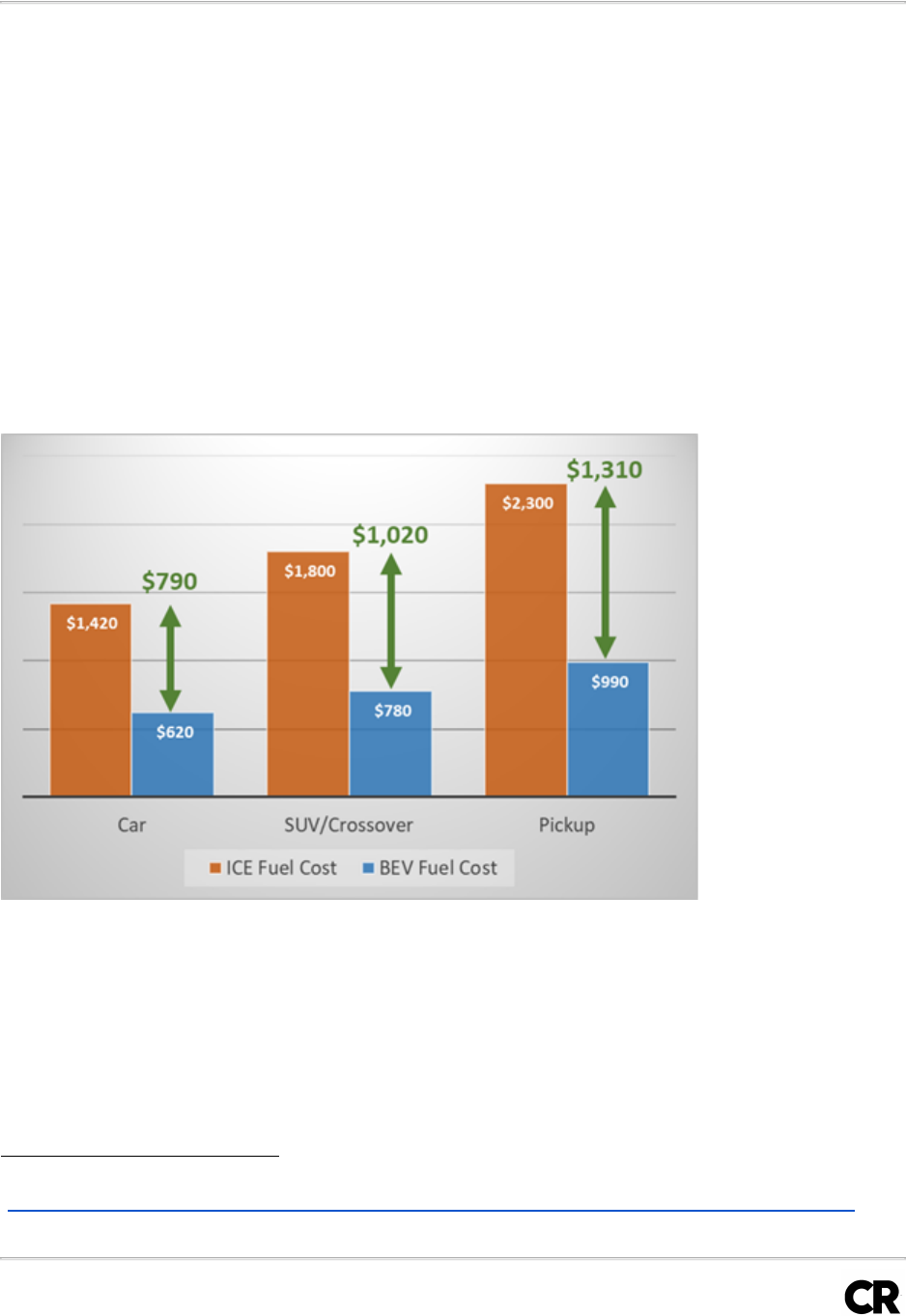
Electric Vehicle Ownership Costs: Today’s Electric Vehicles Offer Big Savings for Consumers
15
stations every year for the same driving distance in an ICE vehicle. Moving from 250 to 300
miles of range per charge adds 20 percent to the cost, weight, and volume of batteries but
reduces the percentage of total annual miles that require public charging by only 2 percent. At
ranges below 200 miles per charge, the number of annual charging trips for the typical driver
increases much more quickly, potentially indicating why earlier, lower-range EVs were less
popular.
The estimated fuel savings a consumer will experience from buying an EV is illustrated in
Figures 3.1 to 3.3. Figure 3.1 shows the fuel cost for ICE vehicles compared with BEV vehicles
over 15,000 miles, the approximate average annual mileage for owners of new vehicles.
31
This
shows that even factoring in some charging at relatively expensive DC fast chargers, BEVs are
expected to cost about 60 percent less to fuel than comparable ICE vehicles, resulting in $800
to $1,300 in annual savings, depending on vehicle class.
Figure 3.1. Estimated Fuel Cost for 15,000 Miles by Vehicle Class
31
Based on recent NHTSA VMT schedules. See Tables VI-212-214
(https://www.nhtsa.gov/sites/nhtsa.dot.gov/files/documents/final_safe_fria_web_version_200701.pdf).

Electric Vehicle Ownership Costs: Today’s Electric Vehicles Offer Big Savings for Consumers
16
Figures 3.2 and 3.3 are based on a discounted cash-flow analysis
32
of typical vehicles over the
first ownership period
33
and vehicle lifetime.
34
These values represent the present value (at the
time of purchase) of future fuel savings from the vehicle.
A number of sensitivities were run with different gas-price assumptions, which are detailed in
Appendix A. Even at fairly low gas prices, BEVs offer very large savings over comparable ICE
vehicles in all classes. Using the EIA’s low-gas-price scenario, which projects an average gas
price of $2.33 per gallon over the next 10 years, consumers can still expect to save around one-
third of their fuel costs. However, the recent history of gas prices and economic activity indicates
that dramatic gas-price declines during challenging economic times tend to be relatively short-
lived, while most new vehicles last 15 to 20 years.
35
Because a return to gas prices closer to
what we have experienced over the past decade is likely over the next year or two, as the
economy recovers from its current downturn, consumers are likely to save a lot more over the
first seven years and lifetime of the vehicle than estimated assuming using today’s fuel prices.
Another thing to note is that gasoline and electricity prices can vary significantly from state to
state. We analyzed costs by state; the results are summarized in Appendix B. This analysis
showed that the fuel savings for EVs for 48 of the 50 states were within 30 percent of the
average, with the majority of states falling within 10 percent of the average. The only two states
outside of the 30 percent range were Oregon and Washington, where consumers who switch to
a BEV can expect to see increased savings of 32 percent and 38 percent, respectively,
compared with the national average. The high savings in these states result from a combination
of higher-than-average gas prices and lower-than-average electricity prices because of the
abundance of cheap hydropower in the Pacific Northwest.
32
Present value at a 3 percent discount rate in 2019 dollars.
33
Assumed to be seven years, based on data from IHS Markit
(https://news.ihsmarkit.com/prviewer/release_only/slug/automotive-vehicles-getting-older-average-age-
light-cars-and-trucks-us-rises-again-201).
34
VMT schedules in Tables VI-212-214. Survival weighted average lifetime mileage in Table VI-219.
Lifetime miles rounded down to 200,000 for all vehicle classes from 210,000 for cars and 230,000 for light
trucks
(https://www.nhtsa.gov/sites/nhtsa.dot.gov/files/documents/final_safe_fria_web_version_200701.pdf).
35
Antonio Bento, Kevin Roth, Yiou Zuo, “Vehicle Lifetime Trends and
Scrappage Behavior in the U.S. Used Car Market” (Jan. 18, 2016). Available at
http://faculty.sites.uci.edu/kevinroth/files/2011/03/Scrappage_18Jan2016.pdf.

Electric Vehicle Ownership Costs: Today’s Electric Vehicles Offer Big Savings for Consumers
17
Figure 3.2. Discounted First Owner Fuel Costs for Average BEV and ICE by Vehicle Class
36
Figure 3.3. Discounted Lifetime Fuel Costs for Average BEV and ICE by Vehicle Class
37
36
Present value at 3 percent discount rate 2019 dollars for the first seven years and 200,000-mile, 15-
year lifetime.
37
Present value at 3 percent discount rate 2019 dollars for the first seven years and 200,000-mile, 15-
year lifetime.

Electric Vehicle Ownership Costs: Today’s Electric Vehicles Offer Big Savings for Consumers
18
Chapter 4—Current EV Ownership Costs: Adding Up the Savings
Introduction
This section applies the findings of the previous three chapters to estimate the relative
ownership costs of currently available battery electric vehicles, plug-in hybrid electric vehicles,
and comparable internal combustion engine vehicles.
While EVs save consumers money through lower fuel and maintenance costs, most EVs on the
market today are priced higher than most comparable ICE models in their class, even after
accounting for federal purchase incentives. So this chapter compares the most popular EVs
(both BEVs and PHEVs) that consumers can buy today with the best-selling, top-rated, and
most efficient non-EVs in their class to determine whether, on net, EVs will save consumers
money. It also compares high-performing EVs with the least expensive ICE vehicle in their class
that achieves the same 0-to-60-mph acceleration performance to understand the value that
certain EVs may provide to the subset of consumers who place value on performance.
38
Key Findings
● Seven of the nine most popular EVs on the market cost first-time owners less than the
best-selling, and top-rated ICE vehicles in their class, in many cases matching or
exceeding the performance of some of the top-performing ICE vehicles in their class.
● Lifetime ownership costs for all nine of the most popular EVs on the market under
$50,000 are many thousands of dollars cheaper than the best-selling and top-rated ICE
vehicles in their class, with typical savings ranging between $6,000 and $10,000.
Approach
This analysis focuses on model year 2020 and 2021 BEVs and PHEVs. It brings together
depreciation, financing, fuel, and repair and maintenance costs, and compares them with similar
ICE vehicles. It does not include other vehicle ownership costs, such as sales or property taxes,
registration fees, and insurance. These costs are also important, but they vary much more by
location and driver demographics and history, and are more challenging to generalize.
Furthermore, the cost of installing a home Level 2 charger is also not included. Common
chargers cost between $300 and $700, with an additional $750 for installation if a 240v outlet is
38
In our 2019 fuel economy survey, only 12 percent of consumers said that performance was one of the
top three attributes they wanted to see improved in their current vehicle as compared to 37 percent who
wanted better fuel economy and 26 percent who wanted lower maintenance costs.
https://advocacy.consumerreports.org/wp-content/uploads/2019/08/Consumer-Reports-Fuel-Economy-
Survey-Report-2019-1.pdf.

Electric Vehicle Ownership Costs: Today’s Electric Vehicles Offer Big Savings for Consumers
19
not available.
39
This is not an insignificant cost, and it will have to be factored into a purchasing
decision, but it is a one-time cost that will not have to be repeated for future BEV purchases.
Furthermore, many utilities offer rebates to help reduce the cost of installing an EV charger, and
there is a 30 percent federal tax credit on the purchase and installation of home EV chargers.
40
Also, most PHEVs have small enough batteries that they can often be charged directly from a
standard wall outlet and don’t require a special charger.
41
The EVs included in this analysis were selected based on popularity and price. They fall into a
few categories: BEVs and PHEVs that sold at least 10,000 units in 2019,
42
recently released EV
models (Tesla Model Y and Ford Escape PHEV), and models that are expected to arrive in
dealerships within two months and can currently be ordered (Ford Mach E and Toyota RAV4
Prime). A price cap of $50,000 was also applied, which eliminated Tesla’s Model X and Model
S. This left five BEVs and four PHEVs. These vehicles were then sorted into five vehicle
classes: hatchbacks, sedans, crossovers, luxury sedans, and luxury crossovers.
For each category, four comparable ICE vehicles were selected. For each vehicle class, three
vehicles were selected: the most efficient ICE vehicle, the best-selling ICE vehicle, and the top-
rated by Consumer Reports. Furthermore, all five BEVs and one PHEV had near-class-leading
acceleration performance. To account for this, these vehicles were also matched against a
fourth vehicle, an ICE vehicle selected as having similar 0-to-60-mph acceleration performance.
For all vehicles the lowest trim was selected for comparison, except for the performance
category, where specific trims were selected to find the lowest-cost vehicle in the class that
matched the EV performance level. A summary of the vehicles selected for analysis is shown in
Table 4.1. Detailed characteristics of the individual vehicles can be found in Appendix C.
39
https://www.consumerreports.org/hybrids-evs/how-to-choose-the-best-home-wall-charger-for-your-
electric-vehicle/
40
https://www.chargepoint.com/incentives/home.
41
https://www.energy.gov/eere/electricvehicles/charging-
home#:~:text=Level%201%20adds%20about%202,even%20some%20all%2Delectric%20vehicles.
42
https://insideevs.com/news/343998/monthly-plug-in-ev-sales-scorecard.

Electric Vehicle Ownership Costs: Today’s Electric Vehicles Offer Big Savings for Consumers
20
Table 4.1. Summary of Vehicles Selected for Analysis and Comparison
Vehicle
Category
Hatchback
Sedan
Crossover
Luxury Sedan
Luxury
Crossover
BEV
Chevy Bolt
Nissan Leaf
Ford Mach E
Tesla Model 3
Tesla Model Y
PHEV
Toyota Prius
Prime
Honda Clarity
Ford Escape
PHEV
Toyota RAV4
Prime
Most Efficient
Toyota Prius
Toyota Camry
Hybrid
Toyota RAV4
Hybrid
Lexus LS 300h
Lexus NX300h
Best-Selling
Honda Civic
Hatchback
Toyota Camry
Toyota RAV4
N/A
43
Lexus RX350
Top-Rated
Hyundai
Elantra GT
Subaru Legacy
Mazda CX5
Audi A4
Infinity QX50
Performance
VW Golf GTI
Mazda CX5
GTR Turbo
BMW 330i
BMW x3 m40i
All ownership costs were calculated as a present value at a discount rate of 3 percent. Costs
were calculated separately as capital costs (depreciation and financing) and operating and
maintenance (O&M) costs (fuel and repair and maintenance). Ownership costs were calculated
for two time periods: the first ownership period and vehicle lifetime. For the first owner an
ownership period of seven years was used.
44
For lifetime costs a total lifetime mileage of
200,000 miles was used.
45
For all ownership periods the VMT-per-year figure was determined
using the National Highway Traffic Safety Administration’s recently updated VMT schedules for
cars, SUVs, and pickup trucks.
46
43
The Tesla Model 3 is the best-selling luxury sedan. The BMW 3-series is the best selling ICE vehicle in
the class so the 330i is used as both the best-selling and performance comparison for the Model 3.
44
https://news.ihsmarkit.com/prviewer/release_only/slug/automotive-vehicles-getting-older-average-age-
light-cars-and-trucks-us-rises-again-201.
45
NHTSA projects survival weighted average lifetime mileage of 210,000 miles for cars and 230,000
miles for light trucks. See Table VI-219
(https://www.nhtsa.gov/sites/nhtsa.dot.gov/files/documents/final_safe_fria_web_version_200701.pdf).
46
See Tables VI-212-214
(https://www.nhtsa.gov/sites/nhtsa.dot.gov/files/documents/final_safe_fria_web_version_200701.pdf).

Electric Vehicle Ownership Costs: Today’s Electric Vehicles Offer Big Savings for Consumers
21
For estimating capital costs the vehicle was assumed to be purchased with a six-year loan.
47
The interest rate on the loan was 4.7 percent.
48
The initial purchase price for each vehicle was
obtained from CR partner TrueCar. TrueCar provides an estimated market average price, based
on recent real-world transaction prices, for any vehicle you select. This accounts for the fact that
vehicles rarely sell for their manufacturer’s suggested retail price (MSRP). For EVs for which
federal tax credits were available, the value of the federal tax credit was subtracted from the
vehicle purchase price. Any state tax incentives were not factored into the analysis. For the first
owner, the owner was then assumed to recover the residual value of the vehicle at the time of
sale. A single depreciation curve was applied uniformly to all vehicles based on the analysis in
Chapter 1. The specifics of the depreciation curve are described in Appendix D.
Operating and maintenance costs were calculated based on the approaches laid out in
Chapters 2 and 3. Maintenance costs were calculated each year based on the per-mile
numbers in Table 2.1. Fuel costs were calculated as described in Chapter 3 for BEVs and ICE
vehicles using the EIA’s AEO 2020 baseline scenario gasoline and electricity cost projections
into the future. Vehicle efficiencies were taken from CR’s real-world fuel-economy tests, where
available; EPA ratings were used for vehicles not yet tested by CR.
49
For BEVs the fraction of miles charged at home vs. public fast charging was adjusted for their
actual EPA-rated range, and the range was reduced by 10 percent after five years and 20
percent after 10 years to account for battery degradation.
50
This results in some small increases
in average per-mile charging costs for BEVs over time. For PHEVs the average miles driven on
electricity vs. gasoline was estimated using the Society of Automotive Engineers’ Standard
J2841 Multi-Day Individual Utility Factor.
51
It was developed based on real-world driving data
from individual consumers and estimates the percentage of miles that individuals are likely to
drive on electric vs. gasoline, based on the electric range of their vehicle. All charging for
PHEVs is assumed to be home charging because PHEVs can easily run on gasoline for longer
trips.
Detailed Findings
Across all ownership periods almost all BEVs and PHEVs showed significant savings over all
comparable vehicles. In general, savings were greater relative to the best-selling and Consumer
47
The average new-car loan in June 2020 was 70 months
(https://www.edmunds.com/industry/press/auto-loan-interest-rates-see-a-slight-lift-in-june-according-to-
edmunds.html).
48
Based on rates for consumers with a credit score between 660 and 720
(https://www.experian.com/blogs/ask-experian/auto-loan-rates-by-credit-score).
49
Fueleconomy.gov.
50
Based on data on battery degradation from real-world values averaging 2 percent per year
(https://storage.googleapis.com/geotab-sandbox/ev-battery-degradation/index.html).
51
https://www.sae.org/standards/content/j2841_200903.
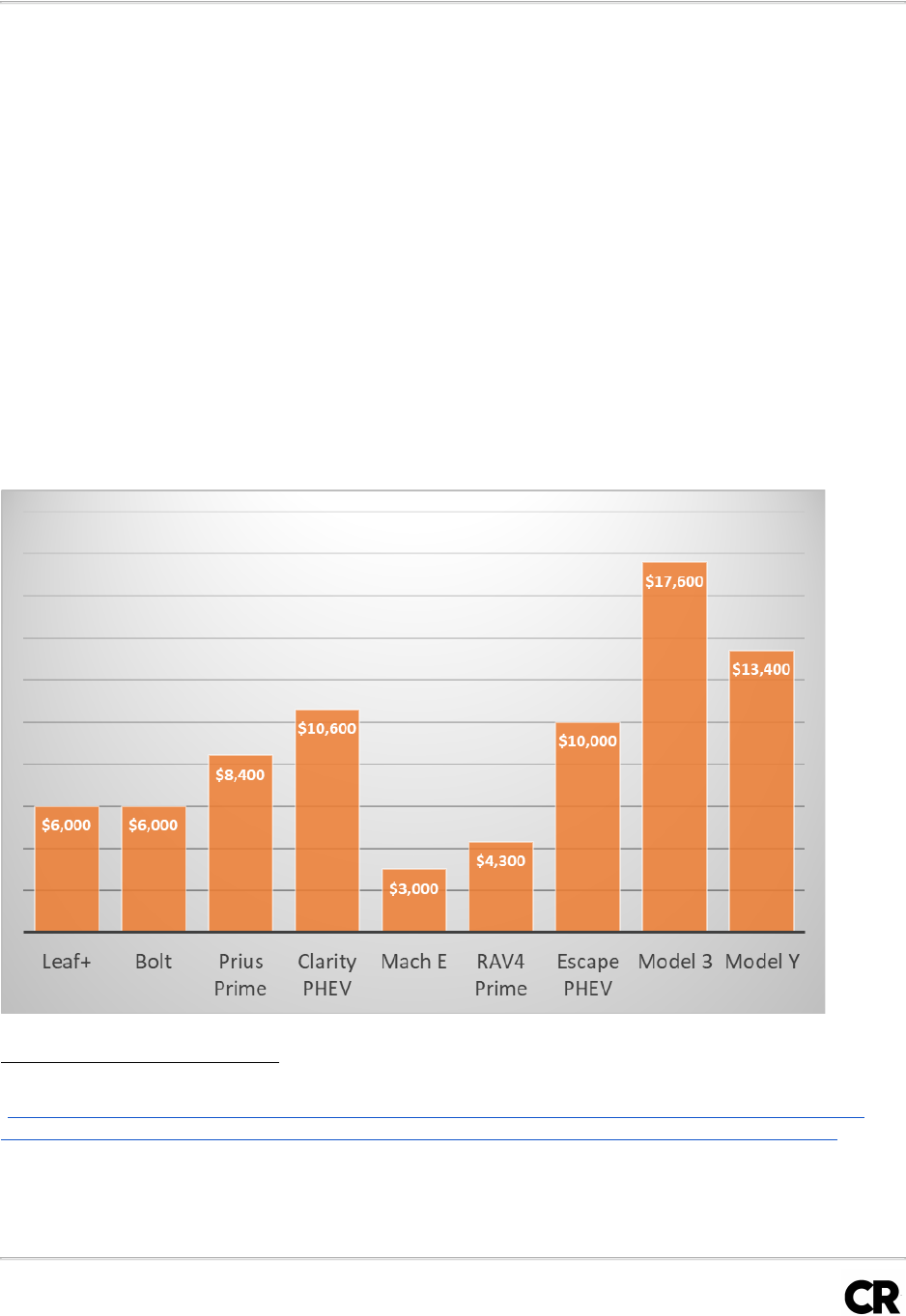
Electric Vehicle Ownership Costs: Today’s Electric Vehicles Offer Big Savings for Consumers
22
Reports’ top-rated vehicles than when compared with the most efficient vehicles. This is
expected because most fuel-efficiency technologies for ICE vehicles are known to pay for
themselves many times over in increased fuel savings, reducing the ownership costs of these
vehicles.
52
Alternatively, savings really ramp up when buyers seek an ICE vehicle that achieves
the same acceleration performance as an EV. This reflects the fact that achieving high
performance in an ICE vehicle requires a larger, more expensive engine that is also much less
efficient, increasing both the capital and operating costs of the vehicle compared with a more
typical vehicle in the class. While most PHEVs are not tuned to perform better than most ICE
vehicles in their class, all BEVs had near-class-leading acceleration performance.
A summary of the present-value lifetime savings for all nine EVs compared with the best-selling
vehicle in their class is presented in Figure 4.1. It shows that in all cases the EV provides
lifetime savings worth thousands of dollars at the time of purchase. This general conclusion also
holds for comparisons with the top-rated and most efficient ICE vehicle
53
in their class. Detailed
cost breakdowns, as well as sensitivity cases, are available for all vehicles in Appendix E.
Figure 4.1. Lifetime Savings From EVs vs. Best-Selling ICE Vehicles in Class
54
52
On average, fuel-efficiency technology was found to provide a 3-to-1 return on investment
(https://advocacy.consumerreports.org/wp-content/uploads/2019/08/The-Un-SAFE-Rule-How-a-Fuel-
Economy-Rollback-Costs-Americans-Billions-in-Fuel-Savings-and-Does-Not-Improve-Safety-2.pdf).
53
For the Ford Mach E, it only breaks even with Toyota RAV4 Hybrid, which costs over $10,000 less and
is highly efficient.
54
Costs as present value at a 3 percent discount rate in 2019 dollars.
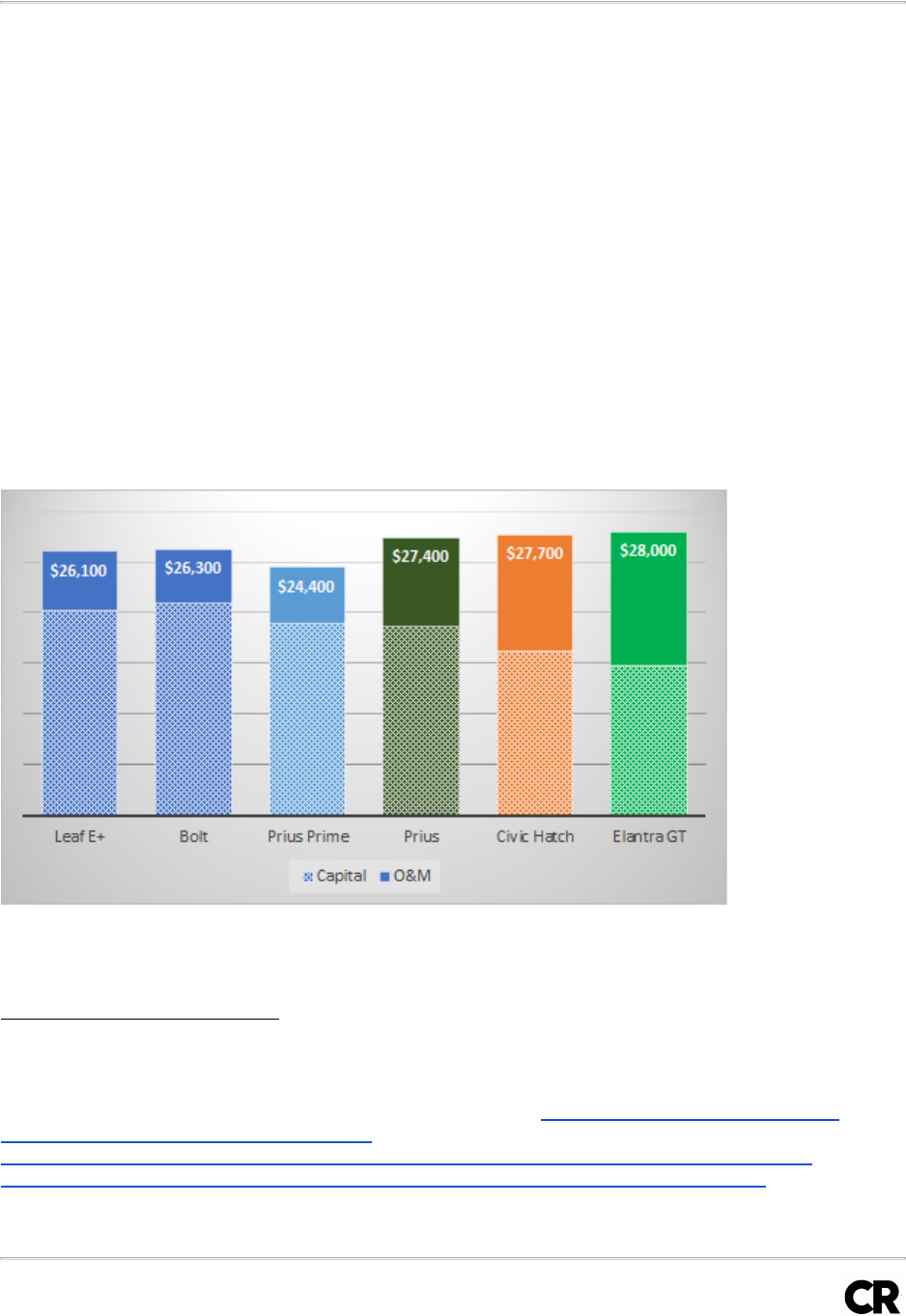
Electric Vehicle Ownership Costs: Today’s Electric Vehicles Offer Big Savings for Consumers
23
Detailed results for the first owner in the hatchback and crossover class are shown in Figures
4.2 and 4.3. These figures break out the capital and O&M costs in addition to the totals. They
illustrate that while in all these cases the EVs had higher capital costs, the cumulative fuel,
repair, and maintenance savings close the ownership cost gap, resulting in overall savings in
most comparisons. The two exceptions are the Toyota RAV4 Prime, which only roughly breaks
even with the base RAV4 LE and the efficient RAV4 hybrid. However the RAV4 prime is
currently selling for an average of more than $1,300 over MSRP,
55
likely indicating that demand
is outpacing supply, which makes sense because it offers a higher trim level and higher
performance at roughly the same net price as the base model. The other vehicle with lower
savings is the Ford Mach E, which is available for preorder at around MSRP and expected to hit
dealer lots in the coming months.
56
This vehicle is designed and marketed to be more of a
performance/semi-luxury vehicle, and its buyers are more likely to be cross shopping for other
higher performance or luxury vehicles than for the base model crossovers it is compared with
here.
Figure 4.2. First Owner Capital, O&M, and Total Costs for Hatchbacks
57
55
This higher purchase price is included in the analysis, so consumers who can buy the vehicle at MSRP
or less will see savings vs. other RAV4 trim levels.
56
Rumored preorder numbers range from fewer than 10,000 to more than 40,000 of an estimated 20,000
model year 2021 vehicles expected to be available in the U.S. (https://electrek.co/2019/11/27/ford-
mustang-mach-e-first-edition-sold-out-year-
early/#:~:text=All%20we%20know%20is%20that,electric%20car%20revealed%20last%20week,
https://www.torquenews.com/9539/2021-ford-mustang-mach-e-order-bank-opens-may-11).
57
Costs as present value at a 3 percent discount rate in 2019 dollars.

Electric Vehicle Ownership Costs: Today’s Electric Vehicles Offer Big Savings for Consumers
24
Figure 4.3. First Owner Capital, O&M, and Total Costs for Crossovers
58
CR surveys have consistently shown that most consumers are satisfied with average
performance and that more consumers would prefer increased fuel economy (37 percent of
consumers) or lower maintenance costs (26 percent) than would prefer more horsepower (12
percent).
59
Automakers, however, focus most of their marketing on performance, making it a key theme in
almost half of their advertisements.
60
Given this heavy industry focus on performance, high-
performing EVs were compared with ICE vehicles that achieve similar 0-to-60-mph acceleration
performance. The results, shown in Figure 4.4, illustrate the first owner and lifetime savings of
high-performing EVs relative to ICE vehicles that achieve similar acceleration levels. The results
are stark: In most cases new-car buyers who care a lot about performance can get that
performance for around $10,000 less by buying an EV.
58
Costs as present value at a 3 percent discount rate in 2019 dollars.
59
https://advocacy.consumerreports.org/wp-content/uploads/2019/08/Consumer-Reports-Fuel-Economy-
Survey-Report-2019-1.pdf.
60
https://advocacy.consumerreports.org/wp-content/uploads/2018/09/auto-ad-content-fact-sheet-
9.19.18.pdf.
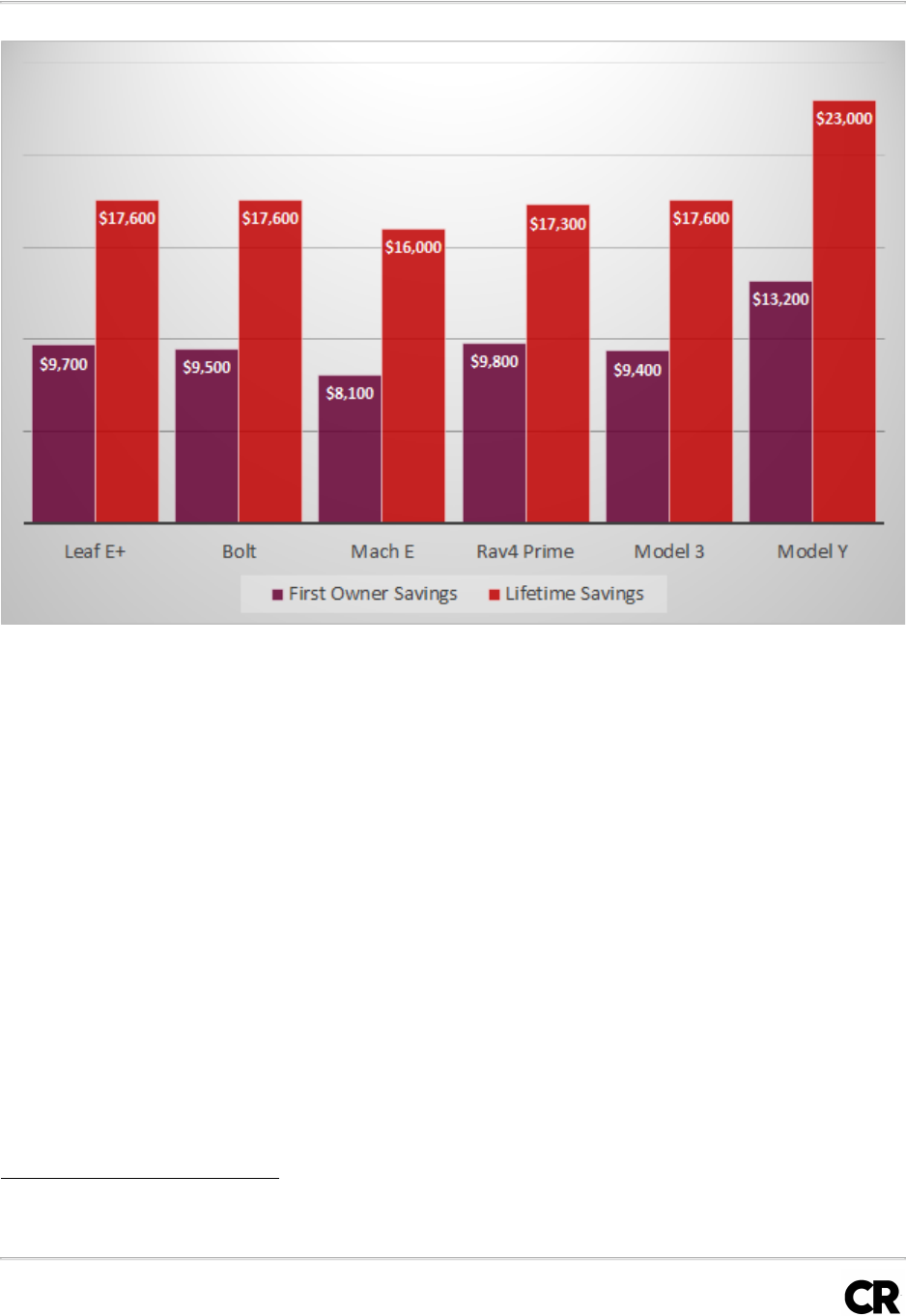
Electric Vehicle Ownership Costs: Today’s Electric Vehicles Offer Big Savings for Consumers
25
Figure 4.4. First Owner and Lifetime Savings From EVs vs. ICE That Matches Acceleration
61
Overall, these results show that many EVs on the market today can provide consumers the two
features they say they most want improved in their next vehicle—lower fuel and maintenance
costs—in addition to the feature the auto industry advertises most often —performance—all at a
lower overall cost.
61
Costs as present value at a 3 percent discount rate in 2019 dollars.

Electric Vehicle Ownership Costs: Today’s Electric Vehicles Offer Big Savings for Consumers
26
Chapter 5—Used EVs: A Pathway Toward More Affordable Transportation
Introduction
While new cars get most of the attention in the automotive industry, used cars account for most
car purchases—70 percent of them in 2019.
62
This is not surprising because used cars can offer
consumers tremendous value: The first owner bears the brunt of the steepest period of
depreciation, while new vehicles today are expected to run for an average of over 200,000
miles.
63
Hence, used-car buyers capture a large fraction of the lifetime utility of a vehicle while
paying a relatively low percentage of the new-car price.
For ICE vehicles this used-car savings is partially offset by higher expected repair and
maintenance costs for older vehicles, and the need to continue to pay for fuel, which makes up
a large fraction of the total lifetime ownership costs for ICE vehicles. However, as shown in the
previous chapters, EVs significantly reduce these costs, while their biggest drawback—higher
purchase prices—is partially offset by depreciation. This chapter explores how the savings
opportunities of EVs only increase for their subsequent owners, offering a potential pathway
toward lowering the cost of transportation for lower-income drivers.
Key Findings
● While new EVs offer significant cost savings over comparable ICE vehicles, the relative
cost savings of an EV purchased when it is 5 to 7 years old can be two or three times as
large.
Approach
The same ownership cost model described in Chapter 4 was used to estimate the potential
savings for used-EV buyers—with a few modifications. Used vehicles were assumed to cost the
residual value plus a dealer markup of 15 percent for 3-year-old vehicles and 20 percent for 5-
year-old and older vehicles.
64
The loan and ownership period were also changed to five years
62
There were 41 million used-car purchases in 2019, according to Edmunds.com, compared with 17
million new-car sales (https://www.edmunds.com/industry/press/used-vehicle-market-poised-for-record-
sales-in-2019-according-to-new-report-from-edmunds.html,
https://www.caranddriver.com/news/a30416492/us-auto-sales-2019).
63
NHTSA projects survival weighted average lifetime mileage of 210,000 miles for cars and 230,000
miles for light trucks, with the average vehicle surviving around 15 years. See Table VI-219
(https://www.nhtsa.gov/sites/nhtsa.dot.gov/files/documents/final_safe_fria_web_version_200701.pdf).
64
Based on analysis of the difference between private party and dealer retail value estimates at
Edmunds.com for the vehicles in the hatchback class included in table 4.1.
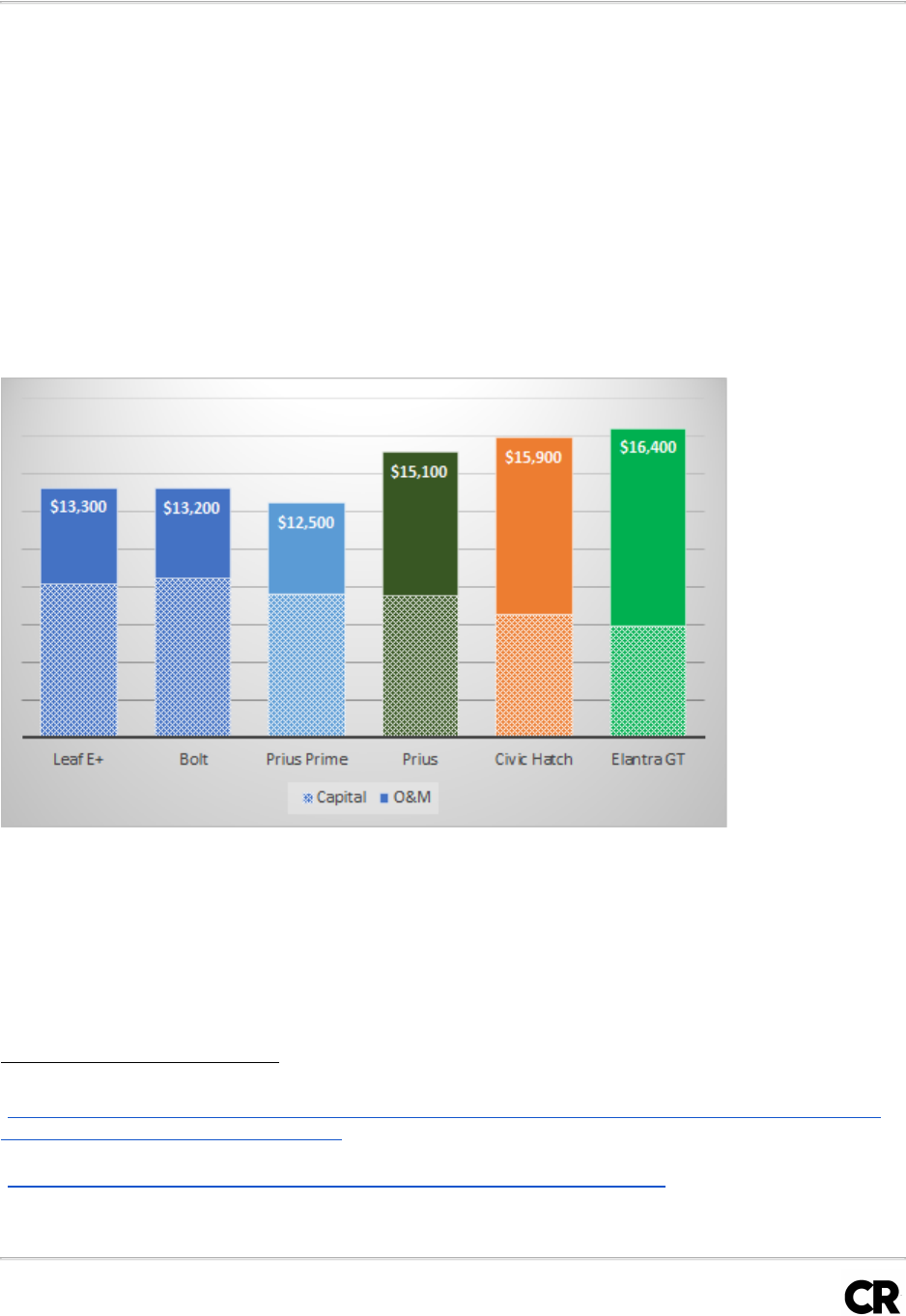
Electric Vehicle Ownership Costs: Today’s Electric Vehicles Offer Big Savings for Consumers
27
each to reflect the typically shorter ownership period of used cars.
65
And the interest rate was
increased to 6 percent to reflect higher rates on used cars.
66
Used vehicles were then analyzed
for vehicles that were purchased when they were 3, 5, and 7 years old.
Detailed Findings
Detailed cost breakdowns are shown in Figure 5.1 for the ownership cost of purchasing a 7-
year-old hatchback. It shows that operation and maintenance costs make up a much larger
percentage of the total ownership costs for used EVs when compared to the new cars analyzed
in the previous chapter. This results in even greater total savings for used EVs vs. comparable
ICE vehicles.
Figure 5.1. 7-Year-Old Used-Vehicle Capital, O&M, and Total Costs for Hatchbacks
67
This increase in savings is better illustrated in Figure 5.2, which shows the percentage savings
for EVs relative to the best-selling vehicle in the class at different purchase times, from new to 7
years old. It shows that while purchasing a new EV saves consumers money, the savings
increase significantly as the vehicle’s age when purchased increases. The reason is that
depreciation reduces the capital cost, increasing the portion of the total cost of ownership from
65
Average ownership period of used cars almost 66 months
(https://news.ihsmarkit.com/prviewer/release_only/slug/automotive-vehicles-getting-older-average-age-
light-cars-and-trucks-us-rises-again-201).
66
Based on rates for consumers with a credit score between 660 and 720
(https://www.experian.com/blogs/ask-experian/auto-loan-rates-by-credit-score).
67
Present value in the year of initial vehicle purchase at a 3 percent discount rate in 2019 dollars.
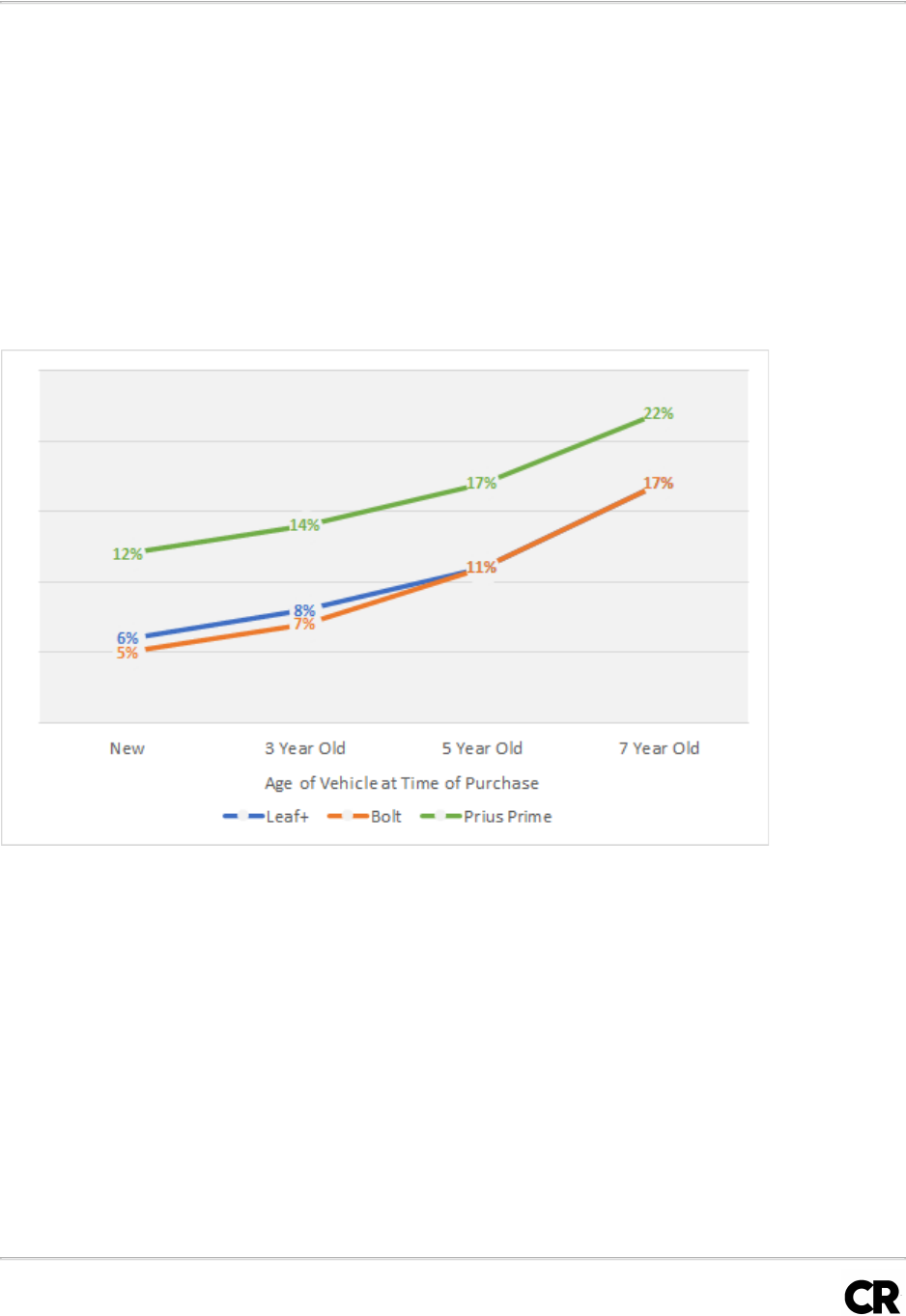
Electric Vehicle Ownership Costs: Today’s Electric Vehicles Offer Big Savings for Consumers
28
operation and maintenance, where EVs have a significant advantage. In fact, the relative
savings from buying an EV are two to three times as high if the EV is a 5- to 7-year-old used
model, compared with purchasing a new EV.
Overall, these results show that used EVs are likely to be a major boon for used-car buyers,
especially lower-income buyers. It will take time until these savings are available to a large
number of consumers, both for the volume of EV sales in the new-car market to increase and
for new EVs to be transferred from their first owners to the secondary market. Unfortunately,
both of these factors will delay the realization of these savings to large numbers of potential
used-car buyers for a number of years.
Figure 5.2. EV Percent Savings Compared With Best-Selling ICE by Vehicle Age at Purchase

Electric Vehicle Ownership Costs: Today’s Electric Vehicles Offer Big Savings for Consumers
29
Appendix A—Fuel-Cost Sensitivities
Table A.1. Discounted Fuel Savings for an Average BEV Compared With Average ICE, by
Class, Assuming National Average Gasoline and Electricity Prices From AEO 2020 Low-Gas-
Price Scenario
Class
15,000 miles
First Owner Savings
Lifetime Savings
Car
$470
$3,100
$5,200
Utility
$610
$4,200
$6,900
Pickup
$790
$5,900
$9,100
Table A.2. Discounted Fuel Savings for an Average BEV Compared With Average ICE, by
Class, Assuming National Average Electricity Prices From AEO 2020 Baseline and Gas Price
From AAA on Aug. 18, 2020
68
Class
15,000 miles
First Owner Savings
Lifetime Savings
Car
$400
$2,600
$4,300
Utility
$520
$3,600
$5,800
Pickup
$670
$5,100
$7,700
68
National average gas price on Aug. 18, 2020, was $2.18 per gallon (https://gasprices.aaa.com).

Electric Vehicle Ownership Costs: Today’s Electric Vehicles Offer Big Savings for Consumers
30
Appendix B—Fuel Costs by State
Table B.1. Savings from an Average BEV vs. an Average ICE per 15,000 Miles of Driving, by State
Car
Crossover/SUV
Pickup
State
Gasoline
Electric
Savings
Gasoline
Electric
Savings
Gasoline
Electric
Savings
Relative Savings vs.
National Average
Alabama
$1,294
$591
$703
$1,648
$742
$906
$2,101
$940
$1,161
-12%
Alaska
$1,863
$917
$946
$2,373
$1,150
$1,223
$3,026
$1,458
$1,568
19%
Arizona
$1,499
$602
$896
$1,909
$756
$1,153
$2,434
$958
$1,476
12%
Arkansas
$1,309
$510
$799
$1,667
$640
$1,027
$2,126
$811
$1,315
0%
California
$1,693
$804
$889
$2,157
$1,009
$1,148
$2,750
$1,279
$1,471
12%
Colorado
$1,388
$597
$791
$1,769
$749
$1,020
$2,255
$950
$1,306
-1%
Connecticut
$1,475
$914
$561
$1,880
$1,148
$732
$2,397
$1,454
$942
-28%
Delaware
$1,439
$638
$801
$1,833
$800
$1,032
$2,337
$1,014
$1,323
1%
Dist. of
Columbia
$1,513
$621
$892
$1,927
$779
$1,148
$2,458
$987
$1,470
12%
Florida
$1,337
$573
$763
$1,703
$720
$983
$2,171
$912
$1,259
-4%
Georgia
$1,296
$577
$719
$1,651
$724
$927
$2,105
$918
$1,187
-10%
Hawaii
$1,863
$1,327
$537
$2,374
$1,665
$709
$3,027
$2,110
$917
-30%
Idaho
$1,479
$514
$965
$1,884
$645
$1,240
$2,403
$817
$1,586
21%
Illinois
$1,378
$612
$765
$1,755
$768
$987
$2,238
$974
$1,264
-4%
Indiana
$1,331
$587
$744
$1,696
$737
$959
$2,162
$933
$1,229
-6%

Electric Vehicle Ownership Costs: Today’s Electric Vehicles Offer Big Savings for Consumers
31
Car
Crossover/SUV
Pickup
State
Gasoline
Electric
Savings
Gasoline
Electric
Savings
Gasoline
Electric
Savings
Relative Savings
Iowa
$1,354
$587
$767
$1,725
$736
$988
$2,199
$933
$1,266
-4%
Kansas
$1,345
$624
$720
$1,713
$783
$930
$2,184
$993
$1,191
-9%
Kentucky
$1,376
$533
$843
$1,753
$669
$1,084
$2,236
$848
$1,388
6%
Louisiana
$1,301
$497
$804
$1,657
$623
$1,034
$2,113
$790
$1,323
1%
Maine
$1,467
$741
$725
$1,868
$930
$938
$2,382
$1,179
$1,204
-8%
Maryland
$1,446
$660
$785
$1,842
$828
$1,013
$2,348
$1,050
$1,298
-1%
Massachusetts
$1,436
$882
$555
$1,830
$1,106
$723
$2,333
$1,402
$931
-29%
Michigan
$1,345
$706
$639
$1,714
$886
$828
$2,185
$1,123
$1,062
-19%
Minnesota
$1,382
$615
$767
$1,761
$771
$989
$2,245
$978
$1,267
-3%
Mississippi
$1,298
$555
$742
$1,654
$697
$956
$2,108
$883
$1,225
-7%
Missouri
$1,314
$561
$752
$1,674
$705
$969
$2,134
$893
$1,241
-5%
Montana
$1,473
$545
$927
$1,876
$684
$1,192
$2,392
$867
$1,525
16%
Nebraska
$1,391
$542
$849
$1,772
$680
$1,092
$2,259
$862
$1,397
6%
Nevada
$1,560
$599
$961
$1,988
$752
$1,236
$2,534
$952
$1,582
20%
New Hampshire
$1,424
$847
$577
$1,814
$1,062
$752
$2,313
$1,346
$967
-26%
New Jersey
$1,393
$732
$661
$1,775
$919
$856
$2,263
$1,165
$1,098
-16%
New Mexico
$1,350
$610
$741
$1,720
$765
$955
$2,194
$970
$1,224
-7%
New York
$1,425
$842
$582
$1,815
$1,057
$758
$2,314
$1,339
$975
-26%

Electric Vehicle Ownership Costs: Today’s Electric Vehicles Offer Big Savings for Consumers
32
Car
Crossover/SUV
Pickup
State
Gasoline
Electric
Savings
Gasoline
Electric
Savings
Gasoline
Electric
Savings
Relative Savings
North Carolina
$1,396
$557
$839
$1,778
$699
$1,079
$2,267
$886
$1,382
5%
North Dakota
$1,437
$511
$926
$1,831
$642
$1,189
$2,335
$813
$1,521
16%
Ohio
$1,389
$614
$775
$1,770
$771
$999
$2,256
$977
$1,279
-3%
Oklahoma
$1,317
$525
$792
$1,678
$659
$1,019
$2,139
$835
$1,304
-1%
Oregon
$1,600
$542
$1,059
$2,039
$680
$1,359
$2,599
$861
$1,738
32%
Pennsylvania
$1,477
$660
$817
$1,882
$829
$1,053
$2,399
$1,050
$1,349
3%
Rhode Island
$1,463
$851
$612
$1,864
$1,068
$795
$2,376
$1,354
$1,022
-22%
South Carolina
$1,314
$616
$698
$1,673
$773
$901
$2,134
$979
$1,154
-12%
South Dakota
$1,401
$564
$837
$1,784
$708
$1,076
$2,275
$897
$1,378
5%
Tennessee
$1,336
$534
$802
$1,702
$670
$1,032
$2,170
$850
$1,321
1%
Texas
$1,298
$566
$732
$1,654
$710
$944
$2,109
$900
$1,209
-8%
Utah
$1,472
$545
$927
$1,875
$684
$1,191
$2,391
$867
$1,524
16%
Vermont
$1,474
$803
$670
$1,877
$1,008
$870
$2,394
$1,277
$1,116
-15%
Virginia
$1,355
$570
$786
$1,727
$715
$1,012
$2,202
$906
$1,296
-1%
Washington
$1,594
$490
$1,104
$2,031
$615
$1,416
$2,589
$779
$1,810
38%
West Virginia
$1,463
$543
$920
$1,864
$682
$1,182
$2,377
$864
$1,513
15%
Wisconsin
$1,422
$670
$752
$1,812
$841
$971
$2,310
$1,065
$1,244
-5%
Wyoming
$1,379
$556
$823
$1,757
$697
$1,059
$2,240
$883
$1,356
3%

Electric Vehicle Ownership Costs: Today’s Electric Vehicles Offer Big Savings for Consumers
33
Appendix C—Vehicle Characteristics
Table C.1. Selected Vehicle Characteristics
Trim
Purchase
Price
69
Fuel
Efficiency
(mpg)
70
Electric
Efficiency
(miles/kWh)
71
Electric
Range
(miles)
0-60
Acceleration
(s)
72
Hatchbacks
Nissan Leaf E+
S Plus
$25,398
3.2
226
7.0
Chevy Bolt
LT
$26,304
3.5
259
6.8
Toyota Prius
Prime
LE
$23,885
54
4
25
10.8
Toyota Prius
LE
$23,443
52
10.3
Honda Civic
Hatchback
LX
$20,363
34
7.1
Hyundai Elantra
GT
GT
Automatic
$18,555
28
8.7
VW Golf GTI
2.0T S DSG
$27,879
27
6.6
Sedans
Honda Clarity
PHEV
Base
$23,345
42
3.3
48
8.3
Toyota Camry
Hybrid
LE
$24,846
47
7.8
Toyota Camry
LE
$21,690
32
8.0
Subaru Legacy
2.5i
$21,168
28
8.9
69
Based on TrueCar.com market average price for Arlington, VA in August 2020 for specified trim with no
options.
70
Based on CR test results when available or EPA when not.
71
Based upon EPA MPGe rating.
72
Numbers from CR tests when available, but based on manufacturer spec or other automotive testing
and rating websites. In general 0-60 times are imprecise measures, with CR numbers often a little higher
than manufacturer spec when available.

Electric Vehicle Ownership Costs: Today’s Electric Vehicles Offer Big Savings for Consumers
34
Trim
Purchase
Price
Fuel
Efficiency
(mpg)
Electric
Efficiency
(miles/kWh)
Electric
Range
(miles)
0-60
Acceleration
(s)
Crossovers
Ford Mach E
Select
$36,495
3.4
230
<6
Toyota RAV4
Prime
SE
$33,105
38
2.8
42
5.7
Ford Escape
PHEV
SE
$28,087
41
3
38
8.7
Toyota RAV4
Hybrid
LE
$27,301
37
7.8
Toyota RAV4
LE
$24,369
27
8.3
Mazda CX5
Sport
$25,021
24
8.6
Mazda CX5 GTR
turbo
GTR Turbo
$34,670
24
6.2
Luxury Sedan
Tesla Model 3
SR Plus
$37,990
4.2
250
5.3
Lexus ES 300h
300h
$41,159
44
8.3
Audi A4
Premium 40
TFSI
$35,953
27
6.3
BMW 330i
73
330i RWD
$39,003
28
6.4
74
Luxury Crossovers
Tesla Model Y
Long Range
$49,990
3.6
316
4.8
Lexus NX hybrid
300h AWD
$38,493
29
8.9
Lexus RX
350 FWD
$42,885
22
7.5
Infinity QX50
Pure
$33,918
22
7.2
BMW X3 m40i
xDrive M40i
$53,105
23
4.8
73
The model 3 is the best selling vehicle in this class, but the BMW 3 series is the best selling ICE vehicle
in the class, so it is used for both the performance and best selling category.
74
CR test result, although rated at around 5.3 seconds elsewhere.

Electric Vehicle Ownership Costs: Today’s Electric Vehicles Offer Big Savings for Consumers
35
Appendix D—Depreciation Curve
Figure D.1. Depreciation Curve

Electric Vehicle Ownership Costs: Today’s Electric Vehicles Offer Big Savings for Consumers
36
Appendix E—Detailed Results of New-Car Ownership Cost Analysis
Table E.1. Detailed Results of New-Car Ownership Cost Analysis for All Vehicles
Initial Ownership Period
Lifetime
Capital
O&M
Total
Capital
O&M
Total
Hatchbacks
Leaf E+
$20,100
$5,900
$26,100
$26,400
$12,500
$38,900
Bolt
$20,900
$5,400
$26,300
$27,300
$11,600
$38,900
Prius Prime
$18,900
$5,500
$24,400
$24,800
$11,700
$36,500
Prius
$18,600
$8,800
$27,400
$24,300
$18,700
$43,000
Civic Hatchback
$16,200
$11,600
$27,700
$21,100
$23,700
$44,900
Elantra GT
$14,700
$13,300
$28,000
$19,300
$26,900
$46,100
Golf GTI
$22,100
$13,600
$35,800
$28,900
$27,500
$56,500
Sedans
Clarity PHEV
$18,500
$6,500
$25,000
$24,200
$12,300
$36,500
Camry Hybrid
$19,700
$9,400
$29,100
$25,800
$19,700
$45,500
Camry
$17,200
$12,100
$29,300
$22,500
$24,700
$47,200
Legacy
$16,800
$13,300
$30,100
$22,000
$26,900
$48,800
Crossovers
Mach E
$28,900
$5,900
$34,800
$37,900
$12,100
$50,000
RAV4 Prime
$26,300
$6,900
$33,100
$34,400
$14,300
$48,600
Escape PHEV
$22,300
$6,600
$28,900
$29,200
$13,800
$42,900
RAV4 Hybrid
$21,700
$11,300
$33,000
$28,300
$22,600
$51,000
RAV4
$19,300
$14,100
$33,500
$25,300
$27,600
$52,900
CX5
$19,800
$15,400
$35,300
$26,000
$29,900
$55,900
CX5 GTR turbo
$27,500
$15,400
$42,900
$36,000
$29,900
$65,900

Electric Vehicle Ownership Costs: Today’s Electric Vehicles Offer Big Savings for Consumers
37
Initial Ownership Period
Lifetime
Capital
O&M
Total
Capital
O&M
Total
Luxury Sedan
Model 3
$30,100
$4,700
$34,800
$39,400
$10,300
$49,800
ES 300h
$32,600
$9,800
$42,400
$42,700
$20,400
$63,200
A4
$28,500
$13,600
$42,200
$37,300
$27,500
$64,800
330i
$30,900
$13,300
$44,200
$40,500
$26,900
$67,400
Luxury Crossovers
Model Y
$39,700
$5,200
$44,900
$51,900
$11,000
$62,900
NX hybrid
$30,500
$13,400
$44,000
$40,000
$26,400
$66,300
RX
$34,000
$16,500
$50,500
$44,500
$31,800
$76,300
QX50
$26,900
$16,500
$43,400
$35,200
$31,800
$67,000
X3 m40i
$42,100
$16,000
$58,100
$55,100
$30,800
$86,000

Electric Vehicle Ownership Costs: Today’s Electric Vehicles Offer Big Savings for Consumers
38
Appendix F—Sensitivity Cases for New-Car Ownership Cost Analysis
This section includes three primary sensitivity cases:
● Gas Prices-This sensitivity case relates to the gas price assumptions. Instead of the
AEO 2020 baseline, the gas prices are changed to match the AEO 2020 low gas price
scenario.
● Vehicle Ownership Period-This sensitivity case changes the initial ownership period
from 7 years to 5 years. In addition, the loan length is changed from 6 years to 5 years.
● Discount Rate-This sensitivity case changes the discount rate from 3% to 7%.
Table F.1. Results of Gas Price Sensitivity, AEO 2020 Low Gas Price
Initial Ownership Period
Lifetime
Capital
O&M
Total
Capital
O&M
Total
Hatchbacks
Leaf E+
$20,100
$5,900
$26,100
$26,400
$12,500
$38,900
Bolt
$20,900
$5,400
$26,300
$27,300
$11,600
$38,900
Prius Prime
$18,900
$5,600
$24,500
$24,800
$10,600
$35,400
Prius
$18,600
$7,700
$26,300
$24,300
$16,400
$40,800
Civic Hatchback
$16,200
$9,800
$26,000
$21,100
$20,300
$41,400
Elantra GT
$14,700
$11,200
$25,900
$19,300
$22,700
$41,900
Golf GTI
$22,100
$11,400
$33,600
$28,900
$23,200
$52,100
Sedans
Clarity PHEV
$18,500
$6,100
$24,600
$24,200
$11,500
$35,800
Camry Hybrid
$19,700
$8,100
$27,800
$25,800
$17,200
$43,000
Camry
$17,200
$10,200
$27,400
$22,500
$21,000
$43,500
Legacy
$16,800
$11,200
$28,000
$22,000
$22,700
$44,600

Electric Vehicle Ownership Costs: Today’s Electric Vehicles Offer Big Savings for Consumers
39
Initial Ownership Period
Lifetime
Capital
O&M
Total
Capital
O&M
Total
Crossovers
Mach E
$28,900
$5,900
$34,800
$38,900
$12,100
$51,000
RAV4 Prime
$26,300
$7,500
$33,800
$34,400
$13,700
$48,100
Escape PHEV
$22,300
$7,200
$29,500
$29,200
$13,300
$42,400
RAV4 Hybrid
$21,700
$9,700
$31,300
$28,300
$19,500
$47,800
RAV4
$19,300
$11,900
$31,200
$25,300
$23,300
$48,600
CX5
$19,800
$12,900
$32,700
$26,000
$25,000
$51,000
CX5 GTR turbo
$27,500
$12,900
$40,400
$36,000
$25,000
$61,000
Luxury Sedan
Model 3
$30,100
$4,700
$34,800
$39,400
$10,300
$49,800
ES 300h
$32,600
$8,400
$41,100
$42,700
$17,700
$60,500
A4
$28,500
$11,400
$40,000
$37,300
$23,200
$60,500
330i
$30,900
$11,200
$42,100
$40,500
$22,700
$63,100
Luxury Crossovers
Model Y
$39,700
$5,200
$44,900
$51,900
$11,000
$62,900
NX hybrid
$30,500
$11,300
$41,800
$40,000
$22,300
$62,200
RX
$34,000
$13,700
$47,700
$44,500
$26,500
$71,000
QX50
$26,900
$13,700
$40,600
$35,200
$26,500
$61,700
X3 m40i
$42,100
$13,300
$55,400
$55,100
$25,700
$80,800

Electric Vehicle Ownership Costs: Today’s Electric Vehicles Offer Big Savings for Consumers
40
Table F.2. Results of Ownership Period Sensitivity, 5 year Initial Ownership Period
Initial Ownership Period
Capital
O&M
Total
Hatchbacks
Leaf E+
$16,600
$4,200
$20,800
Bolt
$17,200
$3,900
$21,000
Prius Prime
$15,600
$4,600
$20,200
Prius
$15,300
$6,200
$21,500
Civic Hatchback
$13,300
$8,300
$21,600
Elantra GT
$12,100
$9,600
$21,700
Golf GTI
$18,200
$9,900
$28,100
Sedans
Clarity PHEV
$15,200
$4,800
$20,000
Camry Hybrid
$16,200
$6,700
$22,900
Camry
$14,200
$8,700
$22,900
Legacy
$13,800
$9,600
$23,400
Crossovers
Mach E
$23,800
$4,100
$28,000
RAV4 Prime
$21,600
$5,500
$27,100
Escape PHEV
$18,300
$5,300
$23,600
RAV4 Hybrid
$17,800
$8,100
$25,900
RAV4
$15,900
$10,200
$26,100
CX5
$16,300
$11,200
$27,500
CX5 GTR turbo
$22,600
$11,200
$33,800

Electric Vehicle Ownership Costs: Today’s Electric Vehicles Offer Big Savings for Consumers
41
Initial Ownership Period
Capital
O&M
Total
Luxury Sedan
Model 3
$24,800
$3,200
$28,000
ES 300h
$26,900
$7,000
$33,800
A4
$23,500
$9,900
$33,400
330i
$25,500
$9,600
$35,100
Luxury Crossovers
Model Y
$32,600
$3,700
$36,300
NX hybrid
$25,100
$9,600
$34,800
RX
$28,000
$12,000
$39,900
QX50
$22,100
$12,000
$34,100
X3 m40i
$34,700
$11,500
$46,200
Table F.3. Results of Discount Rate Sensitivity, 7% Discount Rate
Initial Ownership Period
Lifetime
Capital
O&M
Total
Capital
O&M
Total
Hatchbacks
Leaf E+
$18,600
$5,100
$23,700
$23,200
$9,400
$32,600
Bolt
$19,300
$4,700
$24,000
$24,000
$8,700
$32,700
Prius Prime
$17,500
$5,500
$23,000
$21,800
$9,000
$30,800
Prius
$17,200
$7,600
$24,800
$21,400
$14,000
$35,400
Civic Hatchback
$14,900
$10,000
$24,900
$18,600
$17,900
$36,500
Elantra GT
$13,600
$11,500
$25,100
$16,900
$20,300
$37,200
Golf GTI
$20,400
$11,800
$32,200
$25,500
$20,800
$46,200

Electric Vehicle Ownership Costs: Today’s Electric Vehicles Offer Big Savings for Consumers
42
Initial Ownership Period
Lifetime
Capital
O&M
Total
Capital
O&M
Total
Sedans
Clarity PHEV
$17,100
$5,600
$22,700
$21,300
$9,400
$30,700
Camry Hybrid
$18,200
$8,100
$26,300
$22,700
$14,800
$37,500
Camry
$15,900
$10,400
$26,300
$19,800
$18,600
$38,400
Legacy
$15,500
$11,500
$27,000
$19,300
$20,300
$39,600
Crossovers
Mach E
$26,700
$5,100
$31,800
$33,300
$9,100
$42,500
RAV4 Prime
$24,300
$6,500
$30,800
$30,200
$10,600
$40,800
Escape PHEV
$20,600
$6,300
$26,800
$25,700
$10,200
$35,900
RAV4 Hybrid
$20,000
$9,800
$29,800
$24,900
$17,200
$42,100
RAV4
$17,900
$12,200
$30,100
$22,300
$21,000
$43,300
CX5
$18,300
$13,300
$31,700
$22,900
$22,800
$45,700
CX5 GTR turbo
$25,400
$13,300
$38,700
$31,700
$22,800
$54,500
Luxury Sedan
Model 3
$27,800
$4,000
$31,900
$34,700
$7,700
$42,400
ES 300h
$30,200
$8,400
$38,600
$37,600
$15,300
$52,900
A4
$26,300
$11,800
$38,100
$32,800
$20,800
$53,600
330i
$28,600
$11,500
$40,100
$35,600
$20,300
$55,900
Luxury Crossovers
Model Y
$36,600
$4,500
$41,100
$45,700
$8,300
$54,000
NX hybrid
$28,200
$11,600
$39,800
$35,200
$20,100
$55,200
RX
$31,400
$14,300
$45,700
$39,200
$24,300
$63,500
QX50
$24,900
$14,300
$39,100
$31,000
$24,300
$55,300
X3 m40i
$38,900
$13,800
$52,700
$48,500
$23,500
$72,000

Electric Vehicle Ownership Costs: Today’s Electric Vehicles Offer Big Savings for Consumers
43
Appendix G—Detailed Results of Used-Car Ownership Cost Analysis
Table G.1. Costs of Used Vehicles Over Five Year Ownership Period
3-year-old used vehicle
5-year-old used vehicle
7-year-old used vehicle
Capital
O&M
Total
Capital
O&M
Total
Capital
O&M
Total
Hatchbacks
Leaf E+
$13,600
$4,700
$18,300
$11,200
$5,000
$16,200
$8,100
$5,100
$13,300
Bolt
$14,100
$4,300
$18,400
$11,600
$4,700
$16,300
$8,400
$4,800
$13,200
Prius Prime
$12,800
$4,400
$17,200
$10,500
$4,700
$15,200
$7,600
$4,800
$12,500
Prius
$12,600
$7,100
$19,600
$10,300
$7,500
$17,800
$7,500
$7,600
$15,100
Civic Hatchback
$10,900
$9,000
$19,900
$9,000
$9,300
$18,300
$6,500
$9,400
$15,900
Elantra GT
$9,900
$10,100
$20,100
$8,200
$10,500
$18,600
$5,900
$10,500
$16,400
Golf GTI
$14,900
$10,400
$25,300
$12,300
$10,700
$23,000
$8,900
$10,700
$19,600
Sedans
Clarity PHEV
$12,500
$4,800
$17,300
$10,300
$4,700
$15,000
$7,500
$4,500
$12,000
Camry Hybrid
$13,300
$7,400
$20,800
$10,900
$7,900
$18,800
$7,900
$8,000
$15,900
Camry
$11,600
$9,300
$20,900
$9,500
$9,700
$19,200
$6,900
$9,700
$16,600
Legacy
$11,300
$10,100
$21,500
$9,300
$10,500
$19,800
$6,800
$10,500
$17,200

Electric Vehicle Ownership Costs: Today’s Electric Vehicles Offer Big Savings for Consumers
44
3-year-old used vehicle
5-year-old used vehicle
7-year-old used vehicle
Capital
O&M
Total
Capital
O&M
Total
Capital
O&M
Total
Crossovers
Mach E
$19,600
$4,800
$24,300
$16,000
$5,100
$21,200
$11,700
$5,300
$16,900
RAV4 Prime
$17,700
$5,600
$23,300
$14,600
$5,500
$20,100
$10,600
$5,300
$15,900
Escape PHEV
$15,100
$5,400
$20,400
$12,400
$5,300
$17,700
$9,000
$5,100
$14,100
RAV4 Hybrid
$14,600
$9,000
$23,600
$12,000
$9,500
$21,500
$8,700
$9,500
$18,300
RAV4
$13,100
$10,900
$24,000
$10,700
$11,300
$22,100
$7,800
$11,400
$19,200
CX5
$13,400
$11,800
$25,200
$11,000
$12,200
$23,200
$8,000
$12,200
$20,200
CX5 GTR turbo
$18,600
$11,800
$30,400
$15,200
$12,200
$27,500
$11,100
$12,200
$23,300
Luxury Sedan
Model 3
$20,400
$3,900
$24,200
$16,700
$4,300
$21,000
$12,200
$4,400
$16,600
ES 300h
$22,100
$7,700
$29,800
$18,100
$8,200
$26,300
$13,200
$8,200
$21,400
A4
$19,300
$10,400
$29,600
$15,800
$10,700
$26,500
$11,500
$10,700
$22,200
330i
$20,900
$10,100
$31,000
$17,200
$10,500
$27,600
$12,500
$10,500
$22,900
Luxury Crossovers
Model Y
$26,800
$4,300
$31,100
$22,000
$4,800
$26,800
$16,000
$4,900
$20,900
NX hybrid
$20,600
$10,400
$31,100
$16,900
$10,900
$27,800
$12,300
$10,900
$23,200
RX
$23,000
$12,600
$35,600
$18,900
$12,900
$31,800
$13,700
$12,900
$26,600
QX50
$18,200
$12,600
$30,800
$14,900
$12,900
$27,800
$10,800
$12,900
$23,700
X3 m40i
$28,500
$12,200
$40,700
$23,400
$12,600
$35,900
$17,000
$12,500
$29,500

Electric Vehicle Ownership Costs: Today’s Electric Vehicles Offer Big Savings for Consumers
45
